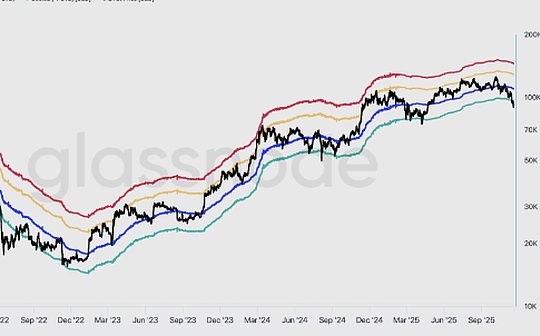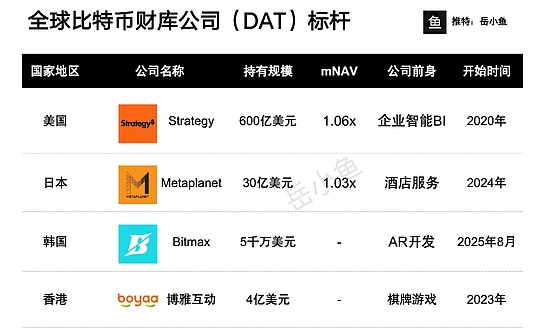
Source: Grayscale; Compiled by Deng Tong, Bitchain Vision
summary
-
The results of the U.S. election push Bitcoin to a record high.Although cryptocurrencies are a bipartisan issue, Grayscale Research expects that the Republican unified control of the White House and Congress should lead to legislative and regulatory oversight being more conducive to industry innovation.President-elect Trump’s nomination for key cabinet positions appears to be consistent with the policy agenda that supports cryptocurrencies.
-
Other major cryptocurrency market developments include the launch of Bitcoin ETP options, the massive purchase of Bitcoin by MicroStrategy, the surge in trading volumes on South Korea’s cryptocurrency exchanges, innovations in artificial intelligence agents, and market focus on Dogecoin.
-
2024 is a favorable time for cryptocurrency returns, and Grayscale Research believes the bull market may continue next year.
Bitcoin had appreciated 60% in 2024 before November, but the gains last month brought its year-to-date return to 110%.Unlike previous months, the favorable crypto market environment in November far exceeds Bitcoin: Our Crypto Industry Market Index (CSMI) measures returns on various digital assets, which rose 59% in the month.There are also positive returns throughout the year now (Table 1).
Chart 1: Bitcoin has appreciated 110% this year
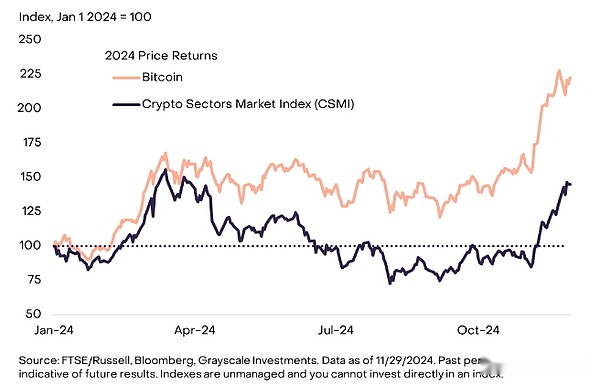
Although cryptocurrencies are a global phenomenon, Grayscale Research believesThe recent U.S. election result is a potential turning point in the digital asset industry.The next president and Congress may adopt comprehensive crypto legislation and help shape institutional oversight by appointing and identifying key regulatory agencies.These decisions could impact many aspects of U.S. blockchain adoption and development, including asset tokenization, the use of stablecoins, and the integration of decentralized finance (DeFi) applications with traditional systems.
At the voter level, poll data show that cryptocurrencies are a common concern between the two parties.Democrats have slightly higher Bitcoin ownership than Republicans.But among the current and incoming members of Congress, Republicans have been more determined to support digital asset innovation, and President-elect Trump has also publicly supported the industry.Therefore, we believe that Republican control over the White House and Congress is a positive outcome for the crypto market (see our previous election report for details).Given the past remarks and professional experience in cryptocurrencies of the two candidates, Scott Bessent’s nomination as Finance Minister and Howard Lutnick’s commerce minister is the incoming governmentencouraging early signs.[2]
Although many assets appreciated after the U.S. election, Bitcoin and the broader cryptocurrency market are among the best performing segments based on risk adjustments (i.e., taking into account the volatility of each asset).The stock market generally appreciates under financial stocks, which may be due to expectations of lower tax rates and relaxation of regulation in certain industries (Figure 2).Meanwhile, the depreciation of the yuan may be due to the threat of U.S. tariff hikes [3], while gold prices have also fallen, which may reflect a reduced tail risk for controversial election results.
Chart 2: Cryptocurrency Market Outperforms Traditional Assets in November
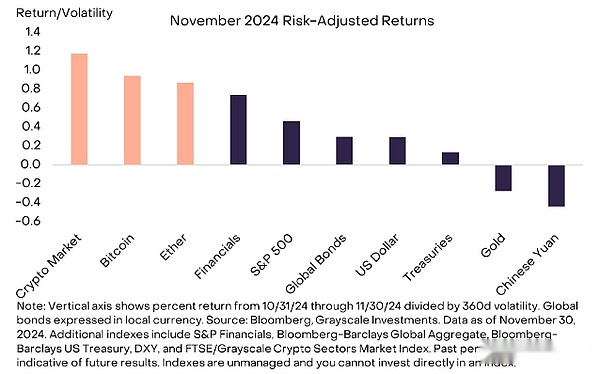
Like many physical commodities, Bitcoin’s price returns are characterized by a high degree of momentum (statistical persistence), which can present the appearance of a price “cycle”.While each period has its specific drivers, past Bitcoin cycles may be partly related to the four-year halving schedule.As Bitcoin matures and adopts a wider range of traditional investors, and the supply impact of a four-year halving declines, the cycle of Bitcoin’s price may decrease.While the price of Bitcoin may always show some momentum—like many physical commodities—the change may not happen every four years.
Nevertheless, past cycles may provide some guidance for typical statistical behaviors of Bitcoin.Bitcoin’s price reached a cyclical low in November 2022 and has continued to appreciate for about two years.The last four Bitcoin price cycles have averaged 2.2 years, and the last two cycles have averaged nearly three years.As far as the current cycle is concerned, the cumulative rate of return so far looks roughly equivalent to the previous two bull markets (Figure 3).While basic variables such as economic conditions and U.S. strength, the dollar will eventually drive the price of Bitcoin, history suggests that the recent price increase may continue.
Chart 3: Bitcoin price tracking before the cycle
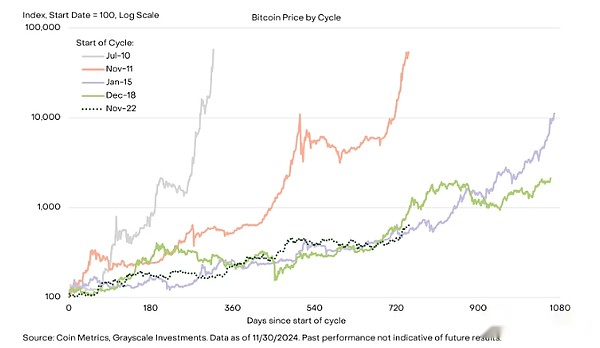
In November, the broader financial market structure surrounding Bitcoin continued to mature.Another net inflow of $6.5 billion in the spot Bitcoin exchange-traded product (ETP) listed in the United States, some of which may have flowed to spot/futures “basis trading.”Bitcoin ETP options also started trading last month.As of November 30, open contracts for Bitcoin ETP products with listed options were $7 billion, of which about 70% were call options and 30% were put options.Improvements in the market structure surrounding spot Bitcoin ETP may ultimately have an impact on agent investments such as MicroStrategy stocks.MicroStrategy is a publicly traded company that is nominally engaged in software business, but mainly serves as a Bitcoin investment vehicle.[4] In November, the company purchased $12 billion in Bitcoin for its balance sheet and announced plans to purchase a total of $42 billion in Bitcoin over the next three years.[5]
From a crypto industry perspective, the best performing segments are consumers and culture, thanks mainly to the strong performance of Dogecoin (DOGE), which rose 161% this month(Figure 4).Although Dogecoin originated from Meme, its blockchain originated from the fork of Bitcoin [6] and has faster blocking time than Bitcoin, Bitcoin Cash and Litecoin, and comparable to BitcoinTrading volume per second.[7]
Calculated by market value,Dogecoin is the largest asset in the field of consumption and culture.On November 12, Trump announced plans to establish the Ministry of Efficiency, abbreviated as DOGE, co-led by Musk, and blockchain has attracted more attention.[8] The department aims to reduce government waste and promote structural reform.Although there is no direct relationship between the proposed sectors, the sharp increase in attention to Musk and DOGE meme may have stimulated demand for the token and raised its price.
Chart 4: Consumer and Culture Cryptocurrency Industry Performs Excellent Due to Meme Coin Demand
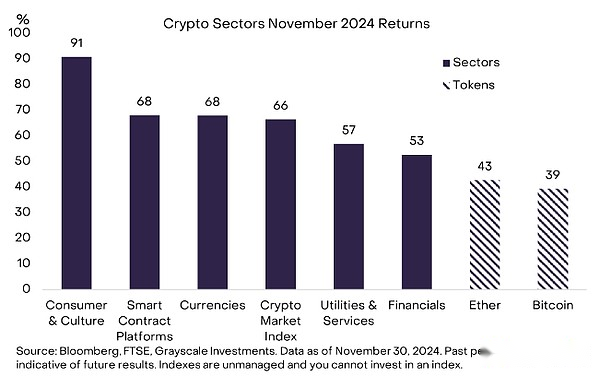
In addition to Bitcoin and Dogecoin, the biggest gains in market capitalization last month were XRP and Stellar Lumens (XLM), two related projects in the currency crypto space initially focused on cross-border remittances, but later expanded to other use cases such asAsset tokenization and support for central bank digital currency (CBDC).XRP has risen 281% since the end of October and XLM has risen nearly 470%.The U.S. election results may provide more regulatory clarity for cryptocurrency projects engaged in remittance applications, which may improve the fundamentals of both projects.However, recent returns may also be driven by special capital flows.In particular, the significant appreciation of XLM corresponds to a surge in trading volumes on the South Korea-centric Upbit exchange, which may indicate that South Korean investors have conducted large-scale speculative trading on XLM (Figure 5).Therefore, the short-term outlook for XLM may depend on the sustainability of demand from these sources, rather than the fundamentals of the project.
Chart 5: South Korea-centric Upbit exchange trading surges

With the smart contract platform, Solana, the crypto industry, continues to outperform Ethereum on the Ethereum network, in part due to the extensive Meme coin transactions on Solana.[9] Solana now incurs fees comparable to Ethereum Layer 1, but its market capitalization is only about a quarter.[10] If Solana can continue to expand adoption beyond Meme coins, such as decentralized physical infrastructure (DePin) or stablecoin payments, Grayscale Research believes it may continue to experience higher fee growth and token pricesPerformance.Among the larger smart contract platform blockchain [11], the best performers are Cardano (+216%), Polkadot (+127%) and Sui (+77%).[12]
Although Ethereum has performed worse than Bitcoin and Solana this year, its performance is roughly consistent with the overall performance of the smart contract platform cryptocurrency industry (Figure 6).Ethereum has a certain competitive advantage and may support adoption in the coming year, including a solid leadership in asset tokenization efforts and an extensive network of application developers.Grayscale Research believesEthereum is “fighting a protracted war”: guiding the network effect by keeping Base and other Layer 2s low fees.existIn a post-election regulatory environment, the trend of institutional adoption of digital assets may help determine whether Ethereum’s scaling strategy will support its leading position in smart contract platforms over time.
Chart 6: Ethereum lags Solana this year
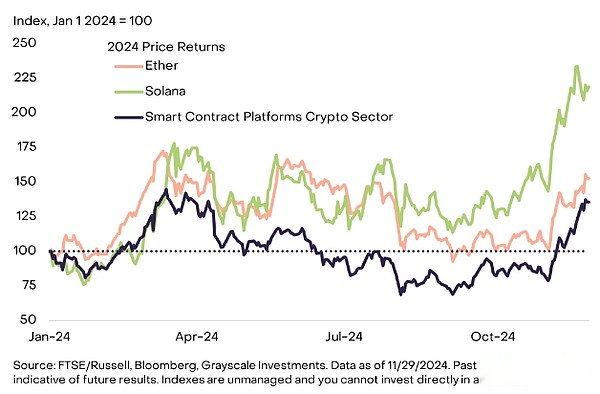
Developers continue to explore innovative applications of blockchain technology.The recent market focus has focused on projects related to decentralized artificial intelligence (deAI).This is a diversified category, but many projects focus on leveraging economic incentives based on blockchain infrastructure to develop components of AI technology in a decentralized way, including data collection and storytelling, computing, and model training andreasoning.In a recent report, Grayscale Research introduced the latest experiment of “AI Influencers”: autonomous AI agents active on social media, able to make and receive payments using blockchain wallets.Another area of innovative marketplaces is Decentralized Science (DeSci), where projects utilize blockchain technology to help create a transparent, accessible and collaborative scientific research environment.In early November, the DeSci event attended by major industry figures attracted more attention to the application of the segment.[13]
Cryptocurrency valuations rose sharply in November, with a series of market signals indicating that speculative traders’ positions are currently relatively long.Without more fundamental information, the cryptocurrency market may fluctuate more ranges in the short term.
However,Looking ahead to next year,Grayscale Research believes that the bull market may continue, especially if the macro context remains favorable (i.e. the economy avoids recession and the Fed lowers interest rates).Investors around the world are adopting Bitcoin as a unique form of currency that provides digital scarcity and censorship resistance.We believe thatDemand for these functions continues to grow as long as the government fails to control the rising debt burden and policymakers bring friction to the fiat currency system through sanctions and other capital controls.Apart from Bitcoin, the market structure is evolving to enable investors to gain more efficient access to crypto assets, and the incoming Congress may bring greater regulatory transparency in the United States.Marketplace, developers continue to bring exciting new applications to the market, such asDecentralized artificial intelligence-related applications.While 2024 is a very good year for the crypto market, we don’t think 2025 is just as good or better.
References
[1] The FTSE/Grayscale Crypto Sectors series indexes are weighted by the square root of the market value of the components, thereby reducing the relative weight of Bitcoin and other large-cap stock tokens.
[3] Source:Reuters.
[4] Source:Financial Times.
[5] Source:Financial Times.
[6] Dogecoin is the fork of Lucky Coin, Lucky Coin is the fork of Litecoin, and Litecoin is the fork of Bitcoin.
[7] The average block interval time in the past year was: Dogecoin (1.1), Bitcoin (9.9), Bitcoin Cash (10.3) and Litecoin (2.5); the average daily transaction volume per second in the past year was successivelyThese are: Dogecoin (6.2), Bitcoin (6.2), Bitcoin Cash (0.8), and Litecoin (3.3).Source: Coin Metrics, Grayscale Investment.Data as of November 29, 2024.For illustration purposes only.
[8] Source:X.com.
[9] Source:Dune Analytics.Please note that this does not include Dogecoin, it has its own blockchain.
[10] Source: Artemis.Data as of November 30, 2024.
[11] Here is defined as a company with a market capitalization of more than $5 billion.
[12] Source: Artemis.Data as of November 30, 2024.
[13] Source:Unchained Crypto.


